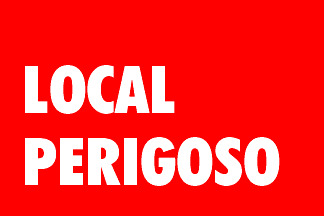 image by António Martins-Tuválkin, 17 September 2007
image by António Martins-Tuválkin, 17 September 2007
Last modified: 2008-08-09 by ian macdonald
Keywords: beach flags |
Links: FOTW homepage |
search |
disclaimer and copyright |
write us |
mirrors
Brazil is country with a very long shore line and many beaches, with warm sunny climate and where beach going is highly popular — for tourists and locals alike. I searched the "interwebs" for some info but found almost nothing substantive.
As usual, at
http://www.mar.mil.br/salvamarbrasil, the official site of the Brazilian
Navy institution which coordinates beach security, there is no useful
information. However, a nice photo at
http://www.flickr.com/photos/jimsk/108973812 seems to imply that red means
unsafe beach condition. At
http://fotolog.terra.com.br/luizd:864 we learn that in Rio in the 1950s red
meant danger and white meant safety, hoisted on a yardarm below the national
flag ("bandeiras hasteadas, abaixo da brasileira, a branca, significando mar
livre, e a vermelha de mar perigoso"). At
http://www.sobrasa.org/biblioteca/bandeiras/bandeiras.htm the site of
Sobrasa (apparently a private lifeguard institution), there is a translation to
Portuguese of an ILS document about recommended beach flag
meanings and designs (more later). This doesn’t mean that this system is in
active use in Brazil.
In
http://teses.ufrj.br/IPPUR_M/IvySchipper.pdf a "lost/found child" flag is mentioned, in use as of 1971 (from
Jornal do
Brasil of 1973.02.18): "bandeiras vermelhas com a cruz branca servem para
que crianças esperem por seus pais enquanto estes não a encontram nas praias."
The design is not clear: either Swiss or Savoian styles are possible, as also
a saltire. The usage is pretty clear, though: rallying point for lost
children to wait for their parents (or whatever guardians) at. Not clear whether this is a system in use or just a proposal. In the same
http://teses.ufrj.br/IPPUR_M/IvySchipper.pdf, a mention of red and yellow
beach warning flags, quoted from O Globo of 1989.11.05: "bandeiras
vermelhas que proíbem banho de mar e" (…) "amarelas que apontam a existência
de valas e correnteza" meaning red flags which forbid swimming and yellow
flags pointing to underwater trenches and strong currents.
At
http://www.cb.sc.gov.br/ccb/dicas_seg/segpraia.htm, the Santa Catarina
state government public safety official website, a classic traffic light
system is described for the state beaches, managed by the State Military
Police Fire Department, with an interesting addition: General beach
conditions are signed by a large flag at the life guard post and specific
dangers are marked locally with a (smaller) red flag reading "local perigoso"
("dangerous place") in white letters set in two lines aligned to the hoist.
A photo at
http://www.cb.sc.gov.br/ccb/dicas_seg/imagem/campan3.jpg was so tortured by
clumsy JPG manipulation that the flag is not readable anymore. I guess that the
readable obverse is with the staff at the viewer’s left hand:
 image by António Martins-Tuválkin, 17 September 2007
image by António Martins-Tuválkin, 17 September 2007
The other flags prescribed by the the SC state government are thus (my translation from http://www.cb.sc.gov.br/ccb/dicas_seg/segpraia.htm: